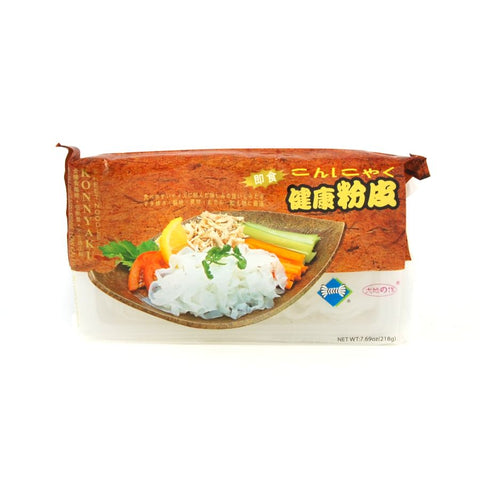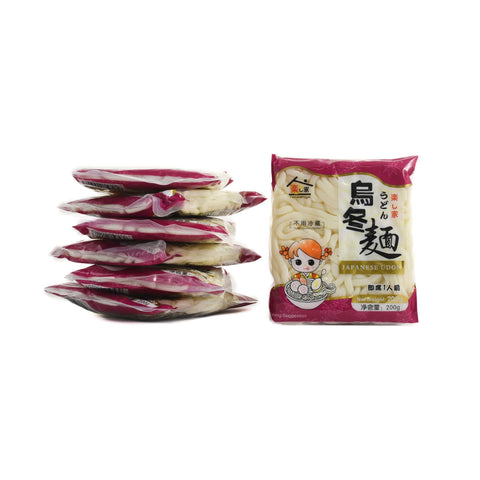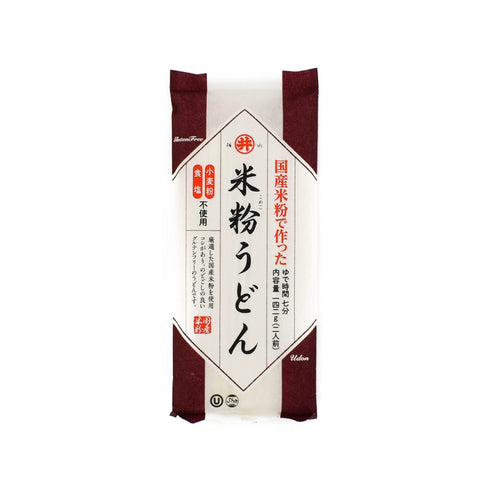A Guide to Thick Rice Noodles: Everything You Need to Know
by Jannika Resido

Thick rice noodles are loved for their texture. They come in many different shapes and sizes - from extra thick, to round and chewy. Read on to find out which is the best thick rice noodle for you.
This guide to thick rice noodles aims to equip you with all the essential information you need before you buy. And explain how to cook rice noodles perfectly.
So, grab a seat at the table and get ready to delve into the fascinating world of thick rice noodles...
Introduction to Thick Rice Noodles
The Origin and Popularity of Thick Rice Noodles
The story of thick rice noodles is steeped in history, originating from the vast and culturally rich regions of East and Southeast Asia.
These noodles are made from rice flour and water, a simple combination that gives them a distinct chewy texture and the ability to absorb flavours well.
Historically used as a staple food, thick rice noodles have become increasingly popular across the globe, featuring prominently in many Asian cuisines.
Their versatility in texture and taste has allowed them to be adapted into a variety of dishes, both traditional and innovative, securing their place in the hearts of food lovers.
As they continue to cross cultural boundaries, the demand for thick rice noodles in diverse culinary settings is a testament to their enduring appeal.
The Nutritional Value of Thick Rice Noodles
Thick rice noodles offer a range of nutritional benefits that contribute to their popularity. They are naturally gluten-free, making them a suitable choice for individuals with gluten intolerances or coeliac disease.
These noodles are a source of carbohydrates, providing the energy required for daily activities.
Although they are not particularly high in protein or fibre, they can be part of a balanced meal when combined with nutrient-rich vegetables, lean proteins, and healthy fats.
It's important to note that thick rice noodles can vary in nutritional content based on their method of preparation and the ingredients they are served with.
To maximise their nutritional value, it's advisable to pair them with a variety of other food groups and to be mindful of portion sizes.
Understanding Different Types of Thick Rice Noodles
The Difference between Flat and Round Thick Rice Noodles
Flat and round thick rice noodles each bring a distinct texture and experience to the dishes they are used in.
Flat thick rice noodles, often seen in dishes like Pad Thai or Pho, have a broad, ribbon-like shape that allows them to hold sauces well and provide a satisfying chew.
They are ideal for stir-fries or soups where they can be the main focus. On the other hand, round thick rice noodles, which are more akin to traditional spaghetti in shape, offer a different mouthfeel.
They are often used in heartier meals where they can absorb rich flavours and add substance to broths and curries.
The surface area of round thai rice noodles is less exposed, so they interact differently with sauces and ingredients.
When choosing between flat and round thick rice noodles, consider the texture you desire and how you want the noodles to interact with other components of your dish.
Types of Thick Rice Noodles You Should Know
Beyond the familiar flat and round varieties, there are several lesser-known types of thick rice noodles that are worth exploring.
Here are some common types of thick rice noodles found across various culinary traditions:
Pad Thai Noodles (Sen Chan)
Pad Thai noodles are perhaps the most well-known type of thick rice noodles. These wide noodles are used in the popular Thai dish Pad Thai, which typically includes stir-fried rice noodles with eggs, tofu, shrimp, bean sprouts, and a flavorful sauce made from tamarind, fish sauce, and palm sugar.
Pad Thai noodles are slightly wider than other varieties, providing a substantial chewiness to the dish.
Ho Fun Noodles
Also known as Shahe fen, these wide and flat rice noodles are a common ingredient in Cantonese cuisine.
Ho Fun noodles are used in dishes like Beef Chow Fun, where they are stir-fried with beef, scallions, and bean sprouts in a savory sauce.
These noodles have a tender yet chewy texture and are often enjoyed for their ability to absorb the flavors of the accompanying ingredients.
Chow Fun Noodles
Similar to Ho Fun noodles, Chow Fun noodles are wide and flat rice noodles used in various Chinese dishes. These noodles are stir-fried with vegetables, meat, and sauce to create flavorful and hearty dishes.
Chow Fun noodles are often used in dishes like Char Kway Teow in Malaysian and Singaporean cuisine, where they are stir-fried with shrimp, squid, Chinese sausage, and bean sprouts.
Guilin Rice Noodles (Mi Fen)
Originating from Guilin, China, Guilin rice noodles are thick rice noodles served in a fragrant and spicy broth made from pork bones, dried shrimp, and various spices.
These noodles are typically topped with sliced pork, pickled mustard greens, peanuts, and herbs.
Guilin rice noodles are known for their robust flavor and satisfyingly chewy texture, making them a popular street food in China.
Banh Canh
Banh Canh are thick and chewy Vietnamese rice noodles made from a combination of rice flour and tapioca starch.
These noodles are typically served in a savory broth with various toppings such as pork, shrimp, fish cakes, and fresh herbs.
Banh Canh noodles are enjoyed for their unique texture, which is both chewy and slippery, as well as their ability to hold up well in hearty soups and stews.
It's interesting to see similar shapes appear in different cuisines. For instance Italian pasta noodle shapes can also be thick:
Pappardelle
Pappardelle pasta noodles are wide ribbons of pasta, typically about 3/4 to 1 inch in width.
Pappardelle is often served with rich, hearty sauces such as ragù alla Bolognese or creamy mushroom sauce, as its broad surface area allows it to hold onto sauces effectively.
Fettuccine
Fettuccine pasta noodles are similar to pappardelle but slightly narrower, typically around 1/2 inch in width.
They have a smooth, flat shape and a slightly thicker texture compared to spaghetti or linguine.
Tagliatelle
Tagliatelle noodles are another variety of thick Italian pasta, similar in width to fettuccine but with a slightly thinner and more delicate texture.
Tagliatelle is often paired with light, delicate sauces such as butter and sage or tomato and basil.
How Thick Rice Noodles are Made
The Traditional Process of Making Thick Rice Noodles
The traditional process of making thick rice noodles is an art that has been passed down through generations. It starts with soaking rice grains overnight to soften them.
The softened rice is then ground into a fine paste and mixed with hot water, to create a milky rice batter. This batter is carefully spread onto a cloth stretched over boiling water and steamed until it forms a thin sheet.
The delicate sheets are then cooled and cut into desired widths to create flat noodles or extruded to form round noodles.
In some regions, these noodles are then placed on bamboo mats or hung over rods to air-dry, which can enhance their texture.
This handcrafted approach to noodle making is labor-intensive but results in noodles with a unique, slightly irregular texture that is highly prized in traditional dishes.
The Modern Machinery Used to Produce Thick Rice Noodles
In contrast to the traditional methods, modern machinery has revolutionised the production of thick rice noodles. High-tech equipment now automates many steps of the process, increasing efficiency and uniformity.
The rice is still soaked and ground, but instead of being hand-spun, the resulting batter is poured into machines that extrude it through moulds.
These machines can produce a consistent noodle width and thickness at a much faster rate.
After extrusion, the noodles are cut to the desired length and then moved through a series of automated steamers and dryers.
Some factories use conveyor belts to transport the noodles through these stages, while others may employ large, rotating drums.
This automation ensures that the noodles are dried uniformly, which is crucial for maintaining quality and texture.
Thanks to modern machinery, the production of thick rice noodles can now meet the demands of a global market while still preserving the essential characteristics that make them a culinary staple.
Cooking with Thick Rice Noodles
Preparing Thick Rice Noodles for Cooking
Cook fresh rice noodles carefully, for the optimal texture. If you're working with dried noodles, they typically require soaking in warm water until they are pliable but still firm.
This step ensures that they don't turn mushy when added to a dish. The soaking time can vary, so it's essential to check the noodles frequently and follow the package instructions.
Fresh rice noodles, on the other hand, may only need a quick rinse under warm water to separate the strands and remove any excess starch.
Whether you're using fresh or dried noodles, it's important to drain them thoroughly under cold water before adding them to your recipe.
This prevents diluting the flavours of your dish and helps the noodles to evenly absorb the sauces and seasonings they are cooked with. Taking the time to cook fresh rice noodles correctly will greatly enhance the final dish.
Recipe Ideas for Thick Rice Noodles
Thick rice noodles are incredibly versatile and can be the foundation for a variety of dishes. A popular option is stir-frying them with a mix of vegetables, prawns, or chicken and a splash of soy sauce for a quick and tasty meal.
They also make an excellent base for curry dishes, absorbing the rich flavours of the sauce. For a comforting bowl, you can immerse them in a fragrant broth to create a noodle soup, topped with fresh herbs and a squeeze of lime.
Another creative use for fried noodles is in salads, where they add substance and pair well with a tangy dressing and crunchy vegetables.
Don't overlook the possibility of using flat rice noodles in place of pasta for a gluten-free alternative in traditional Italian recipes.
These noodles can easily take on a new life with the right sauce and ingredients. Whether you're in the mood for something savoury or spicy, there's a fresh rice noodles recipe that's perfect for you.
Tips for Cooking Perfect Thick Rice Noodles
Cooking perfect flat rice noodles requires a few key tips to ensure they turn out just right. First, it is essential to not over-soak or overcook the noodles, as they can become too soft and lose their texture.
Aim for al dente, which means they should still have a bit of a bite to them.
When stir-frying, use a high heat and cook rice noodles quickly to prevent them from sticking together or to the pan.
Adding a bit of oil can also help with this. Be gentle when tossing the noodles in the pan to maintain their integrity.
If the recipe calls for adding sauce, it's best to do so just before the noodles are fully cooked, as they will continue to cook in the sauce for a short time.
Lastly, don't forget to taste as you go and adjust the cooking time and seasoning to your preference.
With these tips in hand, your thick rice noodles should come out perfectly every time.
Buying and Storing Thick Rice Noodles
What to Look for When Buying Thick Rice Noodles
When purchasing fresh rice noodles, it's important to consider a few factors to ensure you're getting a quality product. Check the expiration date to make sure the noodles are fresh.
If you're buying dried noodles, they should be free from any signs of moisture or clumping, which can indicate they've been exposed to air and might not cook evenly.
For fresh noodles, look for a smooth, uniform texture without any dry edges or discoloration.
Additionally, take into account the width and shape of the noodles based on the dish you plan to prepare, as this can affect the outcome of your recipe.
If you have dietary restrictions, verify the ingredients list for any additives.
Once you've made your purchase, store dried noodles in a cool, dry place, and keep fresh noodles refrigerated and consume them by the recommended date to enjoy their best texture and flavour.
Proper Storage Techniques for Thick Rice Noodles
Storing thick, flat rice noodles correctly is crucial for preserving their quality and extending their shelf life.
For dried rice flour noodles, keep them in an airtight container or resealable bag to protect them from humidity and pests. Store them in a cool, dry cupboard away from direct sunlight.
This will help maintain their texture and prevent them from going stale. Fresh flat rice noodles, however, are more perishable and should be stored in the refrigerator.
If they come in a sealed package, they can be kept in their original packaging until opened.
Once opened, transfer any unused noodles to an airtight container and use them within a couple of days.
For both dried rice noodles and fresh fresh rice noodles however, avoid storing them near strongly scented foods as they can absorb odours. If made with rice flour, these noodles should keep well. Egg noodles may need to be in the fridge.
By following these storage tips, you can ensure that your flat rice noodles remain in top condition until you're ready to use them in your favourite dishes.
Shop thick rice noodles here at Sous Chef!
Konnyaku miracle noodles are a variety of shirataki noodles – famed for having near-zero calories, no sugar, fat or protein. The konnyaku noodles come from the roots of the ‘konjac’ plant in the taro family – which are peeled, cooked, pounded, and then pressed into shape. This variety is a little like tagliatelle - with long, flat, ribbon-like noodles.
This box of 30 udon noodles is your shortcut to fast, delicious dinners. The thick, slightly chewy noodles are perfect for soups and stir-fries.
Made from wheat flour, these Japanese noodles have a neutral taste. They will absorb the flavours of a spicy stir-fry sauce or fragrant ramen broth.
Gluten-free udon rice noodles are a great alternative to traditional wheat varieties. These thick udon noodles can be enjoyed hot or cold. Serve simply with a dipping sauce of soy and mirin. Or serve in a hot broth of miso, dashi and seaweed.

About the author
Jannika Resido is Sous Chef's online content specialist. She is an expert in southeast Asian food and ingredients! Jannika has several years of experience writing blogs and features for online publications. She loves savoury dishes, trying new ingredients (especially the fruity ones!) and discovering recipes from across the world.





